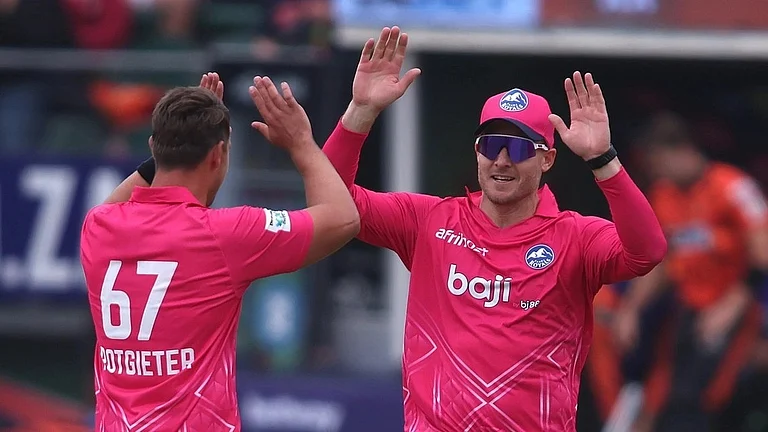IT should have been an easy ride for the Left Front in West Bengal with the Congress and the BharatiyaJanata Party still wrangling over the hawala scam revelations. But barely six weeks prior to the elections, the CPI(M)—the Front's mainstay—seems to have been caught up with the political rigours of being in power for 19 years.
Taking notice of it, the CPI(M) has effected a spring-cleaning of sorts in the party, as is evident from the nomination lists both for the assembly and Lok Sabha elections. For instance, 67 party MLAs have not been renominated for the assembly polls—including ministers Prasanta Sur, Achintya Roy and Patit Paban Pathak and articulate legislators like Santasree Chatterjee and Lakshmi Dey. Says an observer: "One way or another, there was some controversy about these people and questions had been raised about their image." Also dropped from the list was Jyoti Basu's nephew and MP, Amal Datta, and another MP, Saifuddin Chowdhury.
The exclusion of Chowdhury has been controversial—there are murmurs in the party that younger politburo members like Sitaram Yechury and Prakash Karat are responsible for it.
The majority of legislators who were put on the reserve list "to concentrate on other areas of party activity", as the official explanation went, belonged mostly to Howrah, 24-Parganas, Hooghly and Burdwan districts—all party strongholds where the outcome of the civic polls was, at best, mixed. Similarly, for the Lok Sabha polls, the CPI(M) has fielded six new candidates—three from Burdwan itself.
Says a CPI(M) state committee member: "We are not entirely unprepared for a post-election scenario with the Congress winning between 75 and 89 seats (in 1991, it had won just 43 in the 294-strong state assembly). The 25 to 30 marginal seats might go to the opposition. But we are confident that we can retain our single-party-with-absolute-majority status." Considering the fact that the party won more than 180 seats in 1991, even this is a lowering of sights.
State Congress sources do not foresee an upset victory but feel 1996 could well be their best year since 1971, when the party polled a respectable 104 seats to the 113 won by the CPI(M). Says a PCC spokesman: "Reducing the CPI(M)'s strength to less than 150 seats is our number one priority. This would greatly undermine the party's disproportionate political clout at the Centre and increase its dependence on its otherwise nondescript allies like the Revolutionary Socialist Party or the Forward Bloc."
These views encapsulate the immediate objectives of the two major contending parties in the state. If there are more worried, thoughtful faces at Calcutta's Alimuddin Street headquarters of the world's largest elected Communist party than the noisier Congress office on RafiAhmed Kidwai road, it is largely because the more organised Left cannot quite interpret pre-electoral statistics to its own advantage. Since 1993, the share of Congress votes in the state has registered a major increase, whether in the panchayat or in the civic elections.
That the CPI(M) is aware of the task ahead is evident from the way the party is bracing up for the elections. Long before the Election Commission made up its mind, the party's reputed organisational machinery started putting up street corner meetings and rallies at regular intervals. At such meetings, party stalwarts focus on the hawala scam besides highlighting the demerits of the new economic policy. They also dwell at length on the high points of Left Front rule—food grain production has increased to 1,20,000 tonnes from 35,000 tonnes when it came to power in the '70s; the state has made remarkable progress in land reforms (over 17,00,000 landless peasants now own land).
The catalogue of achievements is impressive by any standards, but the fact remains that Front leaders still look worried and the party's young brigade is edgy and often snap at the press at routine briefings. For one thing, the once mighty CPI(M) organisation has lost much of its earlier drive. The party leadership took note of the organisational decline at its last party congress in Calcutta but that clearly isn't enough. Says a senior leader: "The party congress failed to analyse why so many old, dedicated cadres had either let their memberships lapse or had stopped taking interest."
According to Sankar Ghosh, veteran political commentator, "In the pre-Independence days, the Communist Party's ideal was to lure the young. But now, neither the CPI(M) nor the CPI has anything to offer the young. The CPI(M)'s long monopoly of power has drawn to it all sorts of people seeking favour of one kind or another from the party."
Says Dr Zainal Abedin, leader of the Congress Legislative Party: "The state government exaggerates its achievements. What about the miserable state of the government hospitals, the health centres, the primary schools which exist only on paper? What about the politicised, partisan police force which is so demoralised that a handful of hooligans could disrupt the World Cup semi-final between India and Sri Lanka even as the chief minister sat as a mute spectator, bringing shame upon all of us? As for the achievements, let me tell you that even a child knows that unless he belongs to the CPI(M), he will not get anything—a seat in college, a job, a business contract, any relief, or even minimum justice from the police. If the common people were really helped by the Left Front government’s programmes, they would not have voted for us in such large numbers in the panchayat or civic polls."
While the Left's performance in the industrial districts of Howrah, Hooghly and 24-Parganas was a cause for concern, its victories in less urbanised areas like Egra, Islampur and Kulti did not bring much cheer as the votes polled were less than 50 per cent in several areas. In some places, even the BJP was ahead in terms of votes polled. Argues a poll analyst: "The phenomenon is peculiar. Earlier, the Congress' support base was only in the urban areas like greater Calcutta and Howrah. But now, the urban middle class' disenchantment with the Front seems to have infected the suburbs and even the rural areas. This, despite the marked improvement in the living standards of the people in villages. By the early '80s, Midnapore town boasted of air-conditioned bars, and now, the affluent farmers send their children abroad for higher education. If, despite this, the Left's vote begins to decline, it represents a major crisis in its image projection." But if the CPI(M) is suffering from a fit of nerves, the Congress has failed to capitalise on it and is still fighting its internal battles. Says an observer: "The Congress has not yet named its candidates but supporters of rival groups are squabbling over wall space in several areas of the city. The Mamata Banerjee group is at loggerheads with the Somen Mitra camp. The people have been looking for an effective opposition for years in vain. What is the guarantee that 1996 will be any different?"
The CPI(M)is not taking any chances. Says Anil Biswas, central committee member and editor of the party's Bengali mouthpiece, Ganashakti: "One reason why we have been in power for a record period of time is that we have never underestimated the opposition or the Congress. We know the extent of its public support, its reach in virtually every village in the country, regardless of how quarrelsome its leaders may be. People will still continue to vote for it." At a public rally recently, Chief Minister Jyoti Basu went a step further: "People ask me, 'can anyone still vote for the Congress after the hawala revelations?' I always tell them, 'yes, they can and they will and our workers must keep this in mind'." Congress leader Saugata Ray agrees: "We have some hardcore supporters and hawala or not, they will be behind us."
Ironically, the Front is as concerned about the increase in the Congress' vote percentage as it is about the decline in the BJP's following. The BJP polled 11 per cent of the total votes in 1991, which fell to 5 per cent during the civic polls. Observers cannot conceive of a situation where a BJP voter will switch to the CPI(M), but it is not so inconceivable for him to vote for the Congress. A 5-per cent swing in favour of the Congress will have a tremendous impact on the results. Thanks to the Congress' infighting, the Left Front will most likely be re-elected but perhaps with a considerably reduced majority.






















